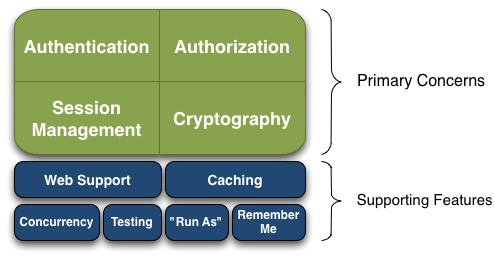本文转载自 燕归来
Apache Shiro是Java的一个安全框架。目前,使用Apache Shiro的人越来越多,因为它相当简单,对比Spring Security,可能没有Spring Security做的功能强大,但是在实际工作时可能并不需要那么复杂的东西,所以使用小而简单的Shiro就足够了。对于它俩到底哪个好,这个不必纠结,能更简单的解决项目问题就好了。
本博文仅仅介绍怎么使用,至于底层原理的源码,待以后再来慢慢分析。
Shiro可以非常容易的开发出足够好的应用,其不仅可以用在JavaSE环境,也可以用在JavaEE环境。Shiro可以帮助我们完成:认证、授权、加密、会话管理、与Web集成、缓存等。这不就是我们想要的嘛,而且Shiro的API也是非常简单;其基本功能点如下图所示:

下面开始一步一步实现Shiro和Spring的继承,项目使用Maven搭建.
POM文件
shiro需要的jar包如下,导入即可
<!--shiro核心包-->
<dependency>
<groupId>org.apache.shiro</groupId>
<artifactId>shiro-core</artifactId>
<version>1.2.2</version>
</dependency>
<!--shiroweb包-->
<dependency>
<groupId>org.apache.shiro</groupId>
<artifactId>shiro-web</artifactId>
<version>1.2.2</version>
</dependency>
<!--spring集成shiro包-->
<dependency>
<groupId>org.apache.shiro</groupId>
<artifactId>shiro-spring</artifactId>
<version>1.2.2</version>
</dependency>
<!--shiro缓存配置-->
<dependency>
<groupId>org.apache.shiro</groupId>
<artifactId>shiro-ehcache</artifactId>
<version>1.2.2</version>
</dependency>
<!--缓存支持包-->
<dependency>
<groupId>net.sf.ehcache</groupId>
<artifactId>ehcache-core</artifactId>
<version>2.5.0</version>
</dependency>
<!--缓存规范接口-->
<dependency>
<groupId>org.slf4j</groupId>
<artifactId>slf4j-jdk14</artifactId>
<version>1.5.6</version>
</dependency>
创建配置文件
在类目录下创建spring-shiro.xml配置文件,内容如下,具体配置信息,参考注释.
<?xml version="1.0" encoding="UTF-8"?>
<beans xmlns="http://www.springframework.org/schema/beans"
xmlns:xsi="http://www.w3.org/2001/XMLSchema-instance"
xmlns:mvc="http://www.springframework.org/schema/mvc"
xmlns:context="http://www.springframework.org/schema/context"
xmlns:aop="http://www.springframework.org/schema/aop"
xsi:schemaLocation="http://www.springframework.org/schema/beans
http://www.springframework.org/schema/beans/spring-beans-4.0.xsd
http://www.springframework.org/schema/mvc
http://www.springframework.org/schema/mvc/spring-mvc-4.0.xsd
http://www.springframework.org/schema/context
http://www.springframework.org/schema/context/spring-context-4.0.xsd
http://www.springframework.org/schema/aop
http://www.springframework.org/schema/aop/spring-aop-4.0.xsd
http://www.springframework.org/schema/tx
http://www.springframework.org/schema/mvc">
<!--配置securityManager-->
<bean id="securityManager" class="org.apache.shiro.web.mgt.DefaultWebSecurityManager">
<!--配置缓存管理器-->
<property name="cacheManager" ref="cacheManager"/>
<!--配置Reamle-->
<property name="realm" ref="customReamle"/>
</bean>
<!--配置缓存管理器-->
<bean id="cacheManager" class="org.apache.shiro.cache.ehcache.EhCacheManager">
<!--缓存管理的配置文件放在类目录下,其配置内容在后文-->
<property name="cacheManagerConfigFile" value="classpath:ehcache.xml"/>
</bean>
<!--配置Reamle-->
<bean id="customReamle" class="com.tao.spring.shiro.CustomReamle">
<!--Reamle域的加密配置-->
<property name="credentialsMatcher">
<!--创建一个Bean -->
<bean class="org.apache.shiro.authc.credential.HashedCredentialsMatcher">
<!--指定的加密方式-->
<property name="hashAlgorithmName" value="MD5"/>
<!--循环加密的次数 1024-->
<property name="hashIterations" value="1024"/>
</bean>
</property>
</bean>
<!--其可以自定的调用Spring IOC容器中Shiro bean的生命周期方法-->
<bean id="lifecycleBeanPostProcessor" class="org.apache.shiro.spring.LifecycleBeanPostProcessor"/>
<!--启用IOC容器中的shiro注解-->
<bean class="org.springframework.aop.framework.autoproxy.DefaultAdvisorAutoProxyCreator"
depends-on="lifecycleBeanPostProcessor"></bean>
<bean class="org.apache.shiro.spring.security.interceptor.AuthorizationAttributeSourceAdvisor">
<property name="securityManager" ref="securityManager"></property>
</bean>
<!--配置Shiro-->
<!--此Bean的id必须和web.xml文件中的shiroFilter过滤器的名称一致,否则会抛出异常-->
<bean id="shiroFilter" class="org.apache.shiro.spring.web.ShiroFilterFactoryBean">
<property name="securityManager" ref="securityManager"/>
<!--设置登陆界面-->
<property name="loginUrl" value="/shiro/toLoginPage"/>
<!--配置详细信息,支持通配符-->
<!-- anon 表示页面不需要登录即可访问-->
<!-- authc 表示页面需要认证才可以访问-->
<!--logout 表示注销认证状态-->
<property name="filterChainDefinitions">
<value>
/login/toLoginPage = anon
/login/toSuccessPage = authc
/api/login = anon
/api/logout = logout
/shiro/toLoginPage = anon
/shiro/toFailPage = anon
/shiro/login* = anon
/shiro/** = authc
</value>
</property>
</bean>
</beans>
创建登陆接口的创建
在登陆接口中,主要的步骤如下
- 获取subject
- 封装UsernameAndPasswordToken对象
- 使用subject进行登陆操作
@RequestMapping(value = "/login", method = RequestMethod.POST)
public ModelAndView getList(String username, String password) {
ModelAndView modelAndView = new ModelAndView();
if (Strings.isNullOrEmpty(username) || Strings.isNullOrEmpty(password)) {
modelAndView.setViewName("redirect:/shiro/toFailPage");
return modelAndView;
}
//获取当前的subject
Subject subject = SecurityUtils.getSubject();
//封装UsernameAndPassword
UsernamePasswordToken token = new UsernamePasswordToken(username, password);
try {
//尝试登陆,如果登录失败会返回不同的异常,这些异常的父类是AuthenticationException
subject.login(token);
modelAndView.setViewName("redirect:/shiro/toSuccessPage");
return modelAndView;
} catch (AuthenticationException ae) {
System.out.println("认证出现异常,异常信息:" + ae.getMessage());
modelAndView.setViewName("redirect:/shiro/toFailPage");
session.setAttribute("exception",ae);
return modelAndView;
}
}
退出登录接口的创建
退出登录接口的操作非常简单,只要获取当前subject,然后使用其logout方法即可,当前或者在spring-shiro.xml文件中使用/** = logout 的方式也可以实现。
@RequestMapping(value = "/logout",method = RequestMethod.GET)
public ModelAndView loginOut(){
SecurityUtils.getSubject().logout();
ModelAndView modelAndView =new ModelAndView("/shiro/login");
return modelAndView;
}
配置Reamle域
Reamle是在spring-shiro中装配的并且在其中我们还是制定了密码的加密方式,下面来实现这个类,实现这个类需要继承Reanle接口,但是我们可以继承这个接口的实现类,从而减少工作量,继承AuthenticatingRealm类,实现其中的doGetAuthenticationInfo(AuthenticationToken authenticationToken) 的方法即可,这里一般使用DAO层方法,做一些密码的验证和获取。
其步骤如下:
1、将authenticationToken强转为UsernameAndPasswordtoken
2、获取用户名和密码
3、调用数据库查询
4、没有用户,返回 UnknownAccountException
public class CustomReamle extends AuthenticatingRealm {
@Override
protected AuthenticationInfo doGetAuthenticationInfo(AuthenticationToken authenticationToken) throws AuthenticationException {
//强转为UsernameAndPassword,这个对象就是我们在Controller层传递的过来的
UsernamePasswordToken token = (UsernamePasswordToken) authenticationToken;
//获取账户和密码
String username = token.getUsername();
String password=new String(token.getPassword());
//一些处理逻辑,这些应该是数据库的查询
//主要是检查账户信息和状态,获得账户实体对象,这里实现了逻辑
//根据数据库查到的结果抛出不同的异常信息
//UnknownAccountException 未知的账户异常
//LockedAccountException 账户已被锁定,无法登陆异常
//当然还有其他的,比如密码错误异常 IncorrectCredentialsException
if (username.contains("123")){
throw new UnknownAccountException("账户不存在");
}
if ("admin".equals(username)){
throw new LockedAccountException("账户被锁定,无法登陆!");
}
//构建返回对象
//用户实体对象,这个对象应该是User表的对应类的实体
Object princial = username;
//由于在Reamle中,我们的配置了加密方式,因此这里也要进行加密,这个密码是从数据苦中获取的加密后的密码
//MD5盐值加密,加密2014次,盐值我们不使用,这里设置为null
SimpleHash md5= new SimpleHash("MD5","123456",null,1024);
Object pass = md5;
//获取当前的域名称,通过这些名称可以获取一些参数
String realName = getName();
//传递用户对象和用户的加密后的密码,shiro自行比较
SimpleAuthenticationInfo sm = new SimpleAuthenticationInfo(princial,pass,realName);
return sm;
}
先前就是这样的一个流程,在spring-shiro.xml文件中配置一些需要登录才能访问的页面权限,即可简单的实现一些登陆操作!

